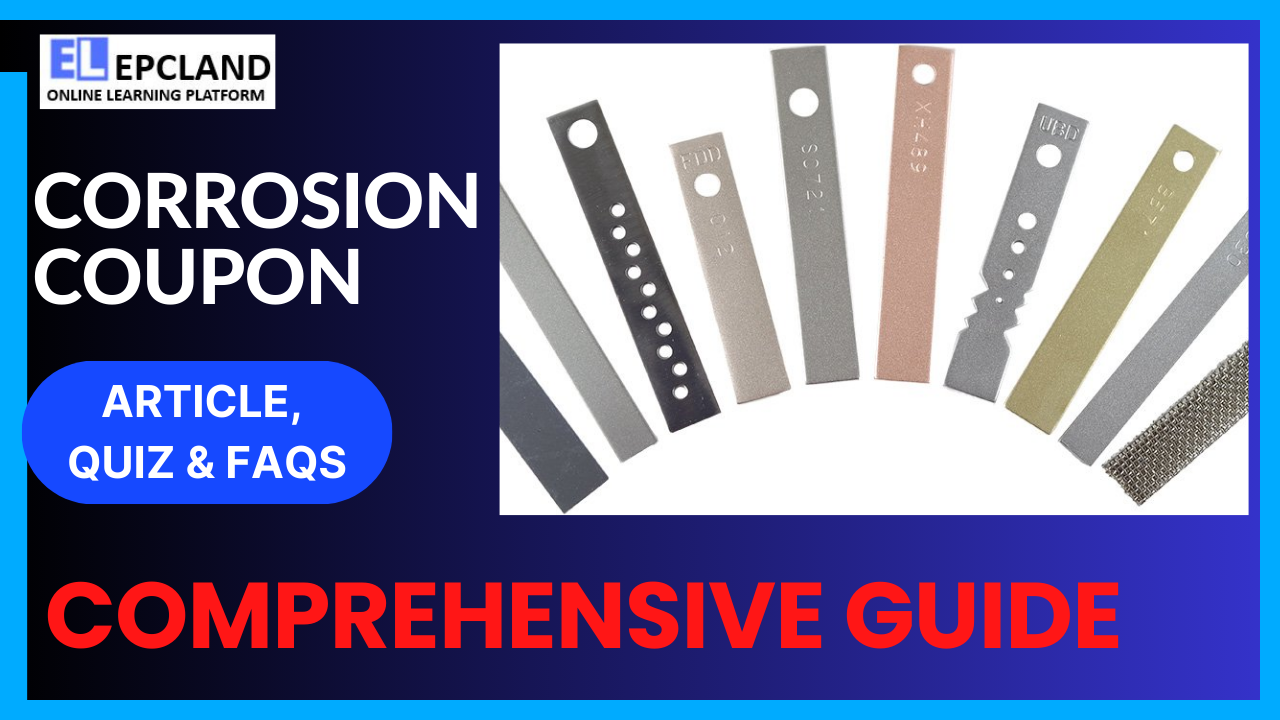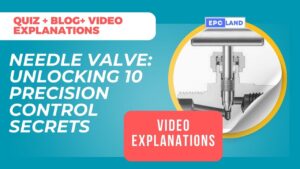I. Introduction
Corrosion is a relentless adversary in the oil and gas industry. It silently erodes pipelines, storage tanks, and other critical equipment, posing a significant threat to infrastructure integrity, safety, and the environment. To combat this formidable foe, engineers and corrosion experts employ a range of tools and techniques, one of which is the corrosion coupon.
In this comprehensive guide, we delve into the world of corrosion coupons, exploring their history, functions, types, applications, advantages, and disadvantages. We also discuss the relevant industry codes and standards that govern their use. By the end, you’ll have a deep understanding of how these unassuming metal specimens play a pivotal role in maintaining the longevity and reliability of oil and gas operations.
Table of Contents
Don’t miss the Complete Course on Piping Engineering: Check Now
Enrollment Link
II. Brief History
The story of corrosion coupons traces back to the early days of the oil and gas industry when the need for systematic corrosion monitoring became apparent. In the late 19th century, as pipelines and storage tanks proliferated, so did the challenges of corrosion. Engineers began seeking ways to quantify and mitigate the effects of corrosion, leading to the development of the first corrosion coupons.
III. Basic Function and Working Principle
3.1. Purpose of Corrosion Coupons
The fundamental purpose of corrosion coupons is to provide a sacrificial metal specimen that corrodes at a known rate in a given environment. By periodically inspecting and analyzing these specimens, engineers can accurately assess the rate and extent of corrosion in the system.
3.2. Working Principle
Corrosion coupons operate on the principle of Galvanic corrosion. When exposed to the corrosive environment within a pipeline or tank, the coupon corrodes while the surrounding equipment remains protected. This sacrificial behavior allows for precise corrosion rate calculations.
Stay tuned as we delve deeper into the various types of corrosion coupons and their specific working mechanisms in the following sections.

IV. Types of Corrosion Coupons
In the oil and gas industry, corrosion coupons are essential tools used for monitoring and measuring the rate of corrosion in pipelines, vessels, and other equipment exposed to corrosive environments. These coupons provide valuable data that help engineers and operators make informed decisions about corrosion control and mitigation strategies. There are several types of corrosion coupons used in the industry, each designed for specific applications and environments. Here are the details about the common types of corrosion coupons used in oil and gas industry projects:
1. Weight Loss Coupons:
- Material: Weight loss coupons are typically made of the same material as the equipment being monitored (e.g., carbon steel, stainless steel, etc.).
- Usage: These coupons are installed in the process stream and exposed to the same corrosive conditions as the equipment. Over time, the coupons corrode, and their weight loss is measured to calculate the corrosion rate.
- Advantages: Simple and cost-effective method for monitoring corrosion. Provides accurate data if properly maintained and calibrated.
2. Electrical Resistance (ER) Coupons:
- Material: ER coupons are made of a conductive material coated with an insulating layer, except for a small exposed area.
- Usage: ER coupons are installed in the process stream. Corrosion leads to a change in electrical resistance, which is measured periodically to determine the corrosion rate.
- Advantages: Provides real-time corrosion rate data without removing the coupon from service. Suitable for high-temperature and high-pressure environments.
3. Linear Polarization Resistance (LPR) Coupons:
- Material: Similar to weight loss coupons, LPR coupons are made of the same material as the equipment.
- Usage: LPR coupons use a small electrical potential to measure the corrosion rate. The polarization resistance is calculated from the current response, providing data on the corrosion rate.
- Advantages: Offers real-time corrosion rate data with high accuracy. Suitable for both laboratory and field applications.
4. High-Temperature Coupons:
- Material: Special alloys are used to withstand high-temperature and high-pressure environments, such as Inconel or Hastelloy.
- Usage: High-temperature coupons are designed for use in extreme conditions, such as in refineries or steam pipelines, where temperatures and pressures are significantly elevated.
- Advantages: Can withstand harsh conditions, providing accurate data even in high-temperature and corrosive environments.
5. Specialized Coated Coupons:
- Material: Base material coated with specific materials like epoxy, polymers, or inhibitors.
- Usage: These coupons are used to simulate specific conditions, such as the presence of inhibitors or coatings, to study their effectiveness in corrosion prevention.
- Advantages: Allows researchers and engineers to test the efficiency of various corrosion inhibitors and coatings under realistic conditions.
6. Hydrogen Permeation Coupons:
- Material: These coupons are made of materials that are sensitive to hydrogen absorption, such as palladium-coated steel.
- Usage: Hydrogen permeation coupons are used to study hydrogen-induced corrosion and measure the rate at which hydrogen permeates the material.
- Advantages: Essential for studying hydrogen-related issues in pipelines and other equipment where hydrogen embrittlement is a concern.
Don’t miss the Complete Course on Piping Engineering: Check Now
Enrollment Link
V. Application of Corrosion Coupons
Battlegrounds in the Oil & Gas Industry
Corrosion coupons find application in various critical areas within the oil and gas industry.
1. Pipelines
In the extensive network of pipelines that transport oil and gas, corrosion poses a constant threat. Corrosion coupons, strategically placed within pipelines, provide insights into corrosion rates, helping operators plan maintenance and prevent catastrophic failures.
2. Storage Tanks
Storage tanks are vulnerable to corrosion due to the corrosive nature of the materials they contain. Coupons placed within tanks allow for continuous monitoring, enabling timely maintenance and extending the lifespan of these essential storage facilities.
VI. Advantages & Disadvantages
Weighing the Pros and Cons
| Aspect | Advantages | Disadvantages |
|---|---|---|
| Cost-Effectiveness | Relatively low cost | Sacrificial nature may lead to frequent replacements |
| Accuracy | Provides accurate corrosion rate data | Results may vary depending on environmental conditions |
| Versatility | Suitable for various applications | Limited to measuring uniform corrosion |
| Durability | Can withstand harsh environments | May not capture localized corrosion |
VII. Associated Codes & Standards
Following the Rules of Engagement
| Organization | Relevant Codes and Standards |
|---|---|
| NACE (National Association of Corrosion Engineers) | NACE SP0204 – Standard Practice: Laboratory Testing of Metals for Resistance to Sulfide Stress Cracking and Stress Corrosion Cracking in H2S Environments |
| American Petroleum Institute (API) | API RP 571 – Damage Mechanisms Affecting Fixed Equipment in the Refining Industry |
VIII. Conclusion
Corrosion, the silent enemy within, continues to threaten the integrity and safety of the oil and gas industry. In this ongoing battle, corrosion coupons have proven to be invaluable allies. Their ability to provide accurate corrosion rate data, versatility, and cost-effectiveness make them essential tools for protecting critical equipment and infrastructure. As we look to the future, the oil and gas industry will continue to rely on these silent watchers to safeguard its operations and the environment.
FAQs
1. What is a corrosion coupon, and how does it work?
- A corrosion coupon is a sacrificial metal sample placed within a system to monitor corrosion rates. It works by measuring changes in its mass or electrical resistance over time as it corrodes, providing valuable data on the rate and severity of corrosion.
2. Why are corrosion coupons important in the oil and gas industry?
- Corrosion coupons are crucial in the industry because they provide real-time data on corrosion rates, helping operators identify and address corrosion issues before they lead to equipment failures or leaks. This proactive approach saves time, money, and enhances safety.
3. What are the different types of corrosion coupons, and when should each type be used?
- There are various types of corrosion coupons, including weight loss coupons, electrical resistance coupons, and linear polarization resistance coupons. Weight loss coupons are commonly used for general monitoring, while electrical resistance coupons are suitable for high-temperature or high-pressure environments. Linear polarization resistance coupons are more advanced and used for research purposes.
4. Where are corrosion coupons typically installed in the oil and gas industry?
- Corrosion coupons are strategically placed in critical areas such as pipelines, storage tanks, and processing equipment. They are installed at locations where corrosion is likely to occur, allowing for continuous monitoring and assessment of the equipment’s integrity.
5. What are the advantages and limitations of using corrosion coupons for monitoring corrosion?
- The advantages of using corrosion coupons include cost-effectiveness, accuracy in corrosion rate measurements, versatility in applications, and durability in harsh environments. However, their sacrificial nature may require frequent replacements, and they may not capture localized corrosion issues.
Recommended courses (Published on EPCLand)
- Basics of Piping Engineering
- Piping Layout Engineering
- Piping Material Engineering
- Piping Stress Analysis
- Complete Course on Piping Engineering
- Material Requisitions
- Piping Material Specifications
- Valve Material Specifications
Don’t miss the published articles on following:
Don’t miss the Complete Course on Piping Engineering: Check Now
Enrollment Link
Attempt Quiz
Question 1:
What is the primary purpose of a corrosion coupon in the Oil & Gas Industry?
Explanation: Corrosion coupons are used to measure the rate of corrosion in pipelines and other equipment in the Oil & Gas Industry.
Question 2:
What is the typical material of a corrosion coupon?
Explanation: Corrosion coupons are typically made of steel, which is exposed to the same environment as the equipment being monitored.
Question 3:
What is the purpose of analyzing a corrosion coupon?
Explanation: Analyzing a corrosion coupon helps in assessing the corrosion rate, providing valuable data for maintenance and prevention.
Question 4:
Where is a corrosion coupon typically placed?
Explanation: A corrosion coupon is typically placed inside a pipeline to monitor the corrosion occurring within the system.
Question 5:
What does a change in the weight of a corrosion coupon indicate?
Explanation: A change in the weight of a corrosion coupon indicates the rate of corrosion occurring in the monitored environment.
Question 6:
What is the primary purpose of using corrosion coupons in the Oil & Gas Industry?
Explanation: Corrosion coupons are used to monitor the effectiveness of corrosion inhibitors in the Oil & Gas Industry.
Question 7:
What does a positive weight loss of a corrosion coupon indicate?
Explanation: A positive weight loss of a corrosion coupon indicates an increase in corrosion rate in the monitored environment.
Question 8:
What is the standard unit for measuring corrosion rate in corrosion coupons?
Explanation: The standard unit for measuring corrosion rate in corrosion coupons is milligrams per square centimeter (mg/cm²).
Question 9:
What does a negative weight loss of a corrosion coupon indicate?
Explanation: A negative weight loss of a corrosion coupon indicates a decrease in corrosion rate in the monitored environment.
Question 10:
What is the primary advantage of using corrosion coupons for monitoring corrosion?
Explanation: The primary advantage of using corrosion coupons for monitoring corrosion is their cost-effectiveness.



